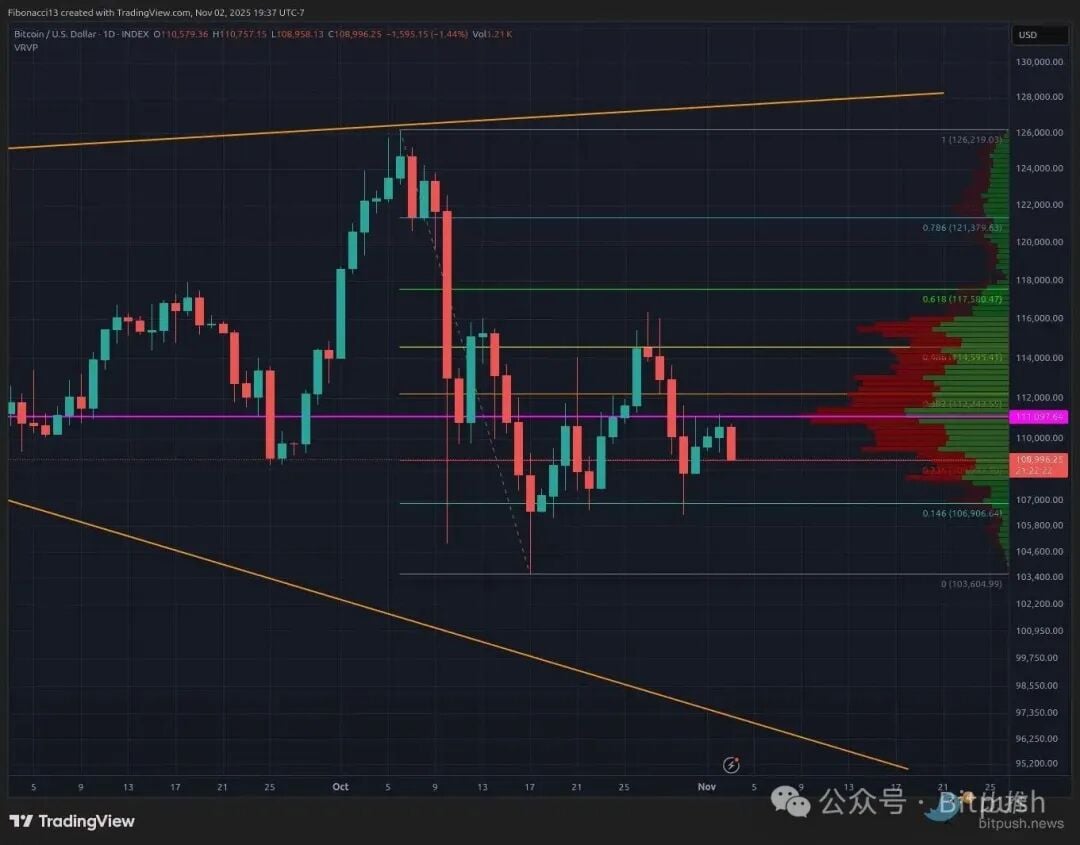The global financial landscape witnessed a sweeping sell-off this week, with a distinct chill settling over investor appetite for risk assets. Bitcoin, the bellwether of the crypto market, breached the crucial psychological barrier of $100,000 on Tuesday, plummeting to a low of $98,962.06. This marked a significant 21% retreat from its October highs, dragging the total cryptocurrency market capitalization down to a four-month nadir of $3.44 trillion.

Technical Levels Under Siege
From a technical standpoint, Bitcoin’s immediate outlook appears challenging. According to analyst Micah Zimmerman, the critical support level at $106,900 – notably aligned with the 0.146 Fibonacci retracement – underwent repeated assaults last week, ultimately failing to galvanize sufficient buying interest. Attention has now shifted to the $104,000 defense line, which has already weathered two tests, indicating a potential erosion of its foundational strength.

Should the $104,000 mark definitively surrender, market participants widely anticipate $96,000 to emerge as the subsequent pivotal support zone. Conversely, for a bullish resurgence, Bitcoin must first reclaim its 21-day exponential moving average and the price control point hovering around $111,000 to reignite upward momentum. Beyond this, a sustained rally would necessitate conquering formidable resistance at $114,600 and $122,000.
Tightening Liquidity Fuels Market Pressure
Amidst the broader market turmoil, bonds stood out as the sole asset class demonstrating resilience this week, while traditional risk assets like Bitcoin, gold, and equities buckled under pressure. Tim Sun, Senior Researcher at HashKey Group, acknowledges the pervasive downward forces but maintains his conviction that $85,000 will serve as a critical support level for Bitcoin.
This sentiment is widely shared across the analytical community. Jiehan Chen, Operations Analyst at Schroder, directly attributes the market’s widespread decline to a strengthening US dollar, which inherently exerts significant downward pressure on dollar-denominated risk assets. Echoing these concerns, Derek Lim, Head of Research at Caladan, remarked in a Bloomberg interview that the cryptocurrency market is grappling with “multiple headwinds.” Lim highlighted the lingering impact of October’s substantial liquidation events and a series of protocol vulnerability exploits, which have collectively “damaged the market’s foundation.” In response, many traders are prudently deleveraging and shying away from aggressive long positions.
A Tale of Two Markets: Panic vs. Fundamentals
Intriguingly, while market sentiment has plummeted, on-chain data paints a starkly different, more resilient picture. XWIN Research, a CryptoQuant certified analyst, suggests that Bitcoin’s dip below the $100,000 threshold is primarily “sentiment-driven.” The widely followed Fear & Greed Index has indeed plunged to an “extreme fear” reading of 21, signaling a foray into irrational market behavior.
Yet, beneath the surface, Bitcoin’s network fundamentals stand remarkably robust. The global hash rate continues to hover near all-time highs, reflecting unwavering network security and miner confidence. Furthermore, a substantial $10.7 billion in stablecoins has flowed into the Binance exchange, accumulating as potential “dry powder” that could fuel a future rebound.

Adding to this narrative, on-chain analytics platform Santiment reports that even amidst the market downturn, a significant number of investors are steadfastly “buying the dip,” indicating underlying conviction. Matt Hougan, Chief Investment Officer at Bitwise, eloquently describes the current environment as “two parallel worlds.” He observes that while “crypto-native investors are in an extremely pessimistic state, with a lot of leverage being cleared,” institutional investors, conversely, “are still enthusiastic about allocating to these assets.”
This intriguing divergence is further corroborated by Bitcoin ETF capital flows. Although the rate of inflows has moderated from Q2 levels, Bitcoin ETFs continue to record stable net inflows. Hougan highlighted Bitwise’s Solana staking ETF, which garnered an impressive $400 million in its inaugural week, underscoring robust institutional demand. However, even this product has not been immune to the recent market turbulence, experiencing a nearly 20% decline since its launch on October 28.
Forecasting the Floor: Divergent Bottom Predictions
The quest to pinpoint Bitcoin’s definitive bottom has yielded a spectrum of opinions among analysts. Ryan Yoon, Senior Analyst at Tiger Research, stands by his $98,000 support assessment, while simultaneously upholding an ambitious long-term target of $200,000. Conversely, HashKey’s Tim Sun posits that a more formidable support lies at $85,000.
Adding a bullish counterpoint, Strategy CEO Michael Saylor, in a recent CNBC interview, reiterated his belief that Bitcoin could ascend to $150,000 by year-end. While the current market climate makes this prediction seem premature, Bitwise’s Matt Hougan views it as far from unreasonable. Hougan elaborated on CNBC, stating, “I think Bitcoin could easily reach a new all-time high before the end of the year. That means reaching around $125,000 to $130,000. Whether it can reach Saylor’s predicted $150,000, we still need to observe.”
Macroeconomic Headwinds and the Path Forward
Despite these varied forecasts, all are subject to the formidable influence of the broader macroeconomic environment. Alarming signals from short-term money markets paint a picture of tightening liquidity: widening spreads, elevated usage of the Federal Reserve’s standing repo facility, and the US Treasury General Account swelling past $1 trillion are collectively siphoning liquidity from the financial system.
Further compounding these pressures is the prospect of a prolonged US government shutdown, which casts a long shadow over economic stability. Against this backdrop, market participants are keenly awaiting the Consumer Price Index (CPI) report on November 13, hoping it might serve as a much-needed catalyst for a shift in sentiment.
In these turbulent and uncertain times, seasoned traders recognize a fundamental truth: a market bottom is rarely a singular, precise point, but rather an expansive region. Within this zone, fear-driven investors perceive heightened risk, while those with a rational, long-term perspective discern invaluable opportunities.
As the market gradually processes the near-term negative catalysts, patient investors who maintain composure amidst the panic may well be accumulating positions for the ensuing upturn. Indeed, the observed rational understanding of crypto asset fundamentals by institutional investors positions them as likely primary drivers of the next significant rally. However, until the market undergoes this essential “emotional cleansing,” investors are advised to exercise patience, as the journey to a true market bottom often proves more circuitous than initially anticipated.





